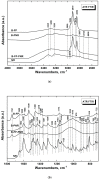Optimization of Electrochemical Visualization of Latent Fingerprints with Poly(Neutral Red) on Brass Surfaces
- PMID: 34641036
- PMCID: PMC8512869
- DOI: 10.3390/polym13193220
Optimization of Electrochemical Visualization of Latent Fingerprints with Poly(Neutral Red) on Brass Surfaces
Abstract
This study is focused on the visualization of latent fingerprints on brass surfaces using the method of electrochemical deposition of a polymer film based on poly(neutral red) (PNR). The experiment included (i) optimization of conditions of electrochemical deposition of PNR on brass surfaces, (ii) ATR-FTIR spectroscopic characterization of PNR-modified substrates, and (iii) identification of characteristic details on visualized fingerprints on fired brass cartridges. For electrochemical visualization, it is necessary to keep in mind both kind and "story" substrates. Experimental findings showed that electrochemical visualization carried out on brass plates is a step forward before known findings described in the literature and gives simultaneously a new approach for criminalists in the fight against crime.
Keywords: brass cartridge; electrochemical deposition; latent fingerprints; poly(neutral red); visualization.
Conflict of interest statement
The authors declare no conflict of interest.
Figures







References
-
- Straus J., Porada V., Fürbach M., Nožička V., Rudáš Z., Suchánek J., Vavera F., Veselá J. Kriminalistická Daktyloskopie. Policejní Akademie ČR; Praha, Czech Republic: 2005. p. 288.
-
- Konrád Z., Porada V., Straus J., Suchánek J. Kriminalistika: Teorie, Metodologie a Metody Kriminalistické Techniky. Aleš Čeněk s.r.o.; Plzeň, Czech Republic: 2014. p. 464.
-
- Langenburg G., Hall C. Wiley Encyclopedia of Forensic Science. John Wiley & Sons Ltd.; Hoboken, NJ, USA: 2013. Friction Ridge Skin: Comparison and Identification. - DOI
LinkOut - more resources
Full Text Sources
Miscellaneous

